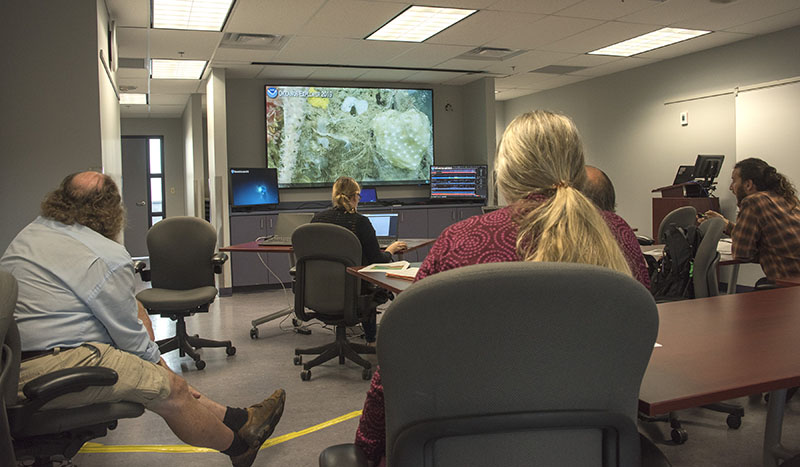
by Lindsay Beazley, Ellen Kenchington, and Rachael Peters, Fisheries and Oceans Canada
September 9, 2019

Scientists participating in dive 1 of the Deep Connections 2019 expedition from the newly established exploration command center at the Bedford Institute of Oceanography, located in Dartmouth, Nova Scotia, Canada. Image courtesy of Fisheries and Oceans Canada. Download larger version (jpg, 3.3 MB).
The Deep Connections 2019 expedition provided the unique opportunity for Canadian scientists and ocean managers to collect data and provide regional expertise on unexplored deep-sea habitats of our Atlantic continental margin—all without actually stepping foot aboard a vessel. This was achieved through NOAA Ship Okeanos Explorer’s state-of-the-art telepresence technology, which was used to transmit real-time video and data collected by its tethered remotely operated vehicles (ROVs) back to shore.
Partnering scientists and managers from two Canadian federal departments, Fisheries and Oceans Canada (DFO) and Natural Resources of Canada (NRCan), engaged in NOAA’s pre-planning and site selection processes for both Leg 1 (mapping only) and Leg 2 (ROV and mapping) of the Deep Connections 2019 expedition. In order to take full-advantage of the scientific opportunities of the expedition, the first-ever Canadian exploration command center (ECC) was established at their home research institute, the Bedford Institute of Oceanography (BIO), while NOAA Ship Okeanos Explorer operated in Canadian waters from August 28 to September 1, 2019.
The Bedford Institute of Oceanography is located in Dartmouth, Nova Scotia on the shores of the Bedford Basin, an inland bay situated at the head of the Halifax Harbor. Established in 1962, BIO is the largest oceanographic research facility in Canada, with over 600 scientists, engineers, technicians, and resource managers across four federal departments, including DFO, NRCan, Environment and Climate Change Canada (ECCC), and the Department of National Defence (DND). Staff at the BIO are all dedicated to conducting government mandated research and providing support to government decision-making on ocean issues.
The establishment of the exploration command center at BIO (coined the ‘BIO-ECC’) allowed for mission personnel to leverage regional expertise in many different disciplines, including benthic ecology, geology, fish ecology, and resource management. The ROV video footage was streamed live at the BIO-ECC, while scientists at BIO provided expert commentary on the biological communities and geological habitats in real time using the NOAA Office of Ocean Exploration and Research’s communications tools. This commentary provided important local expertise and insights to help guide the mission, as well as information to educate members of the public who were watching live online. The collaborative nature of the BIO-ECC allowed its participants to converse with one another about the unique fauna and geological features observed, and come to a consensus on potential sample collections, which were then relayed back to the vessel. During the four ROV dives in Canadian waters, the number of participants of the BIO-ECC ranged from 3 to over 15, including both DFO and NRCan staff, a research professor from the University of North Carolina Wilmington, and personnel from both local and international media.
In addition to the BIO-ECC, the video footage was live-streamed at BIO’s auditorium where visitors to the facility could watch, as well as at the Museum of Natural History in Halifax and the Canadian Museum of Nature in Ottawa. Collectively, several thousand visitors from the public were engaged at these venues. Overall, telepresence technology and the establishment of the BIO-ECC allowed for a deeper participation by Canadian scientists and managers in the Deep Connections 2019 mission, thereby helping to improve our knowledge on previously unexplored areas of the Atlantic continental margin.